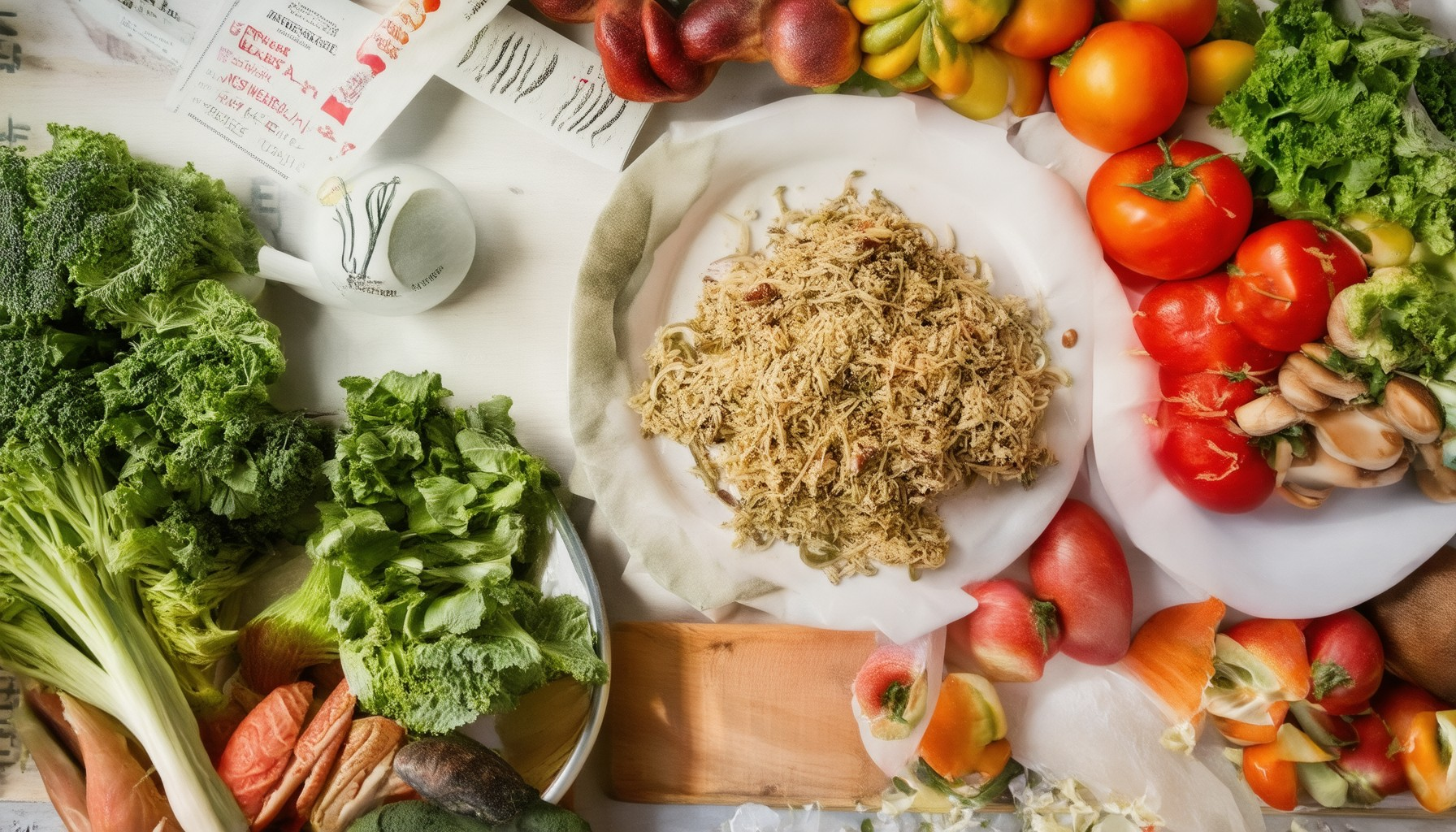Discover the vibrant world of cooking with fresh produce and unlock the endless possibilities that await in your kitchen. Whether you’re strolling through the bustling farmers’ markets or harvesting crops from your own garden, fresh produce offers a unique flavor profile that elevates every dish. This guide delves into the art of preparing fresh pumpkin, selecting the best produce, and crafting delicious, healthy meals that celebrate the seasons. From seasonal recipes to expert tips on storing and preserving fruits and vegetables, this article is your comprehensive resource for making the most of fresh ingredients. Learn how to enhance your culinary creations with fresh greens, herbs, and citrus, and explore the countless ways to integrate these natural flavors into your daily meals. With practical advice and inspiring ideas, this article is your key to unlocking the full potential of fresh produce in your kitchen.
Key Takeaways
- Plan Meals Around Fresh Ingredients: Base your weekly menu on seasonal or freshly harvested produce to minimize waste and maximize flavor.
- Incorporate Fresh Herbs and Spices: Use herbs and spices while they’re at their peak for more aromatic and flavorful dishes.
- Proper Storage Techniques: Keep fruits and vegetables fresh longer with correct storage methods, like using airtight containers for berries and damp paper towels for greens.
- Utilize Every Part of the Vegetable: Don’t discard peels or stems—they’re rich in nutrients and can enhance soups, roasted dishes, or salads.
- Strategic Ingredient Pairing: Combine complementary flavors, such as sweet strawberries with balsamic vinegar or thyme for a refreshing salad.
- Preserve or Ferment Produce: Explore pickling, kimchi, or sauerkraut to extend the life of fresh produce while adding unique tastes to your meals.
- Seasonal Recipes Inspiration: Experiment with recipes tailored to the current growing season for local flavors and sustainable practices.
- Use Kitchen Tools: Store fresh herbs and vegetables in glass jars or mesh bags to keep them fresh and easily accessible.
- Explore Cooking Methods: Master techniques like sautéing, roasting, grilling, boiling, steaming, stir-frying, and pickling to bring out the best in fresh produce.
- Stay Creative and Inspired: Continuously discover new ways to use fresh produce, from traditional methods to innovative twists.

How to Prepare Fresh Pumpkin for Cooking
To prepare fresh pumpkin for cooking, follow these simple steps:
Step 1: Selecting the Right Pumpkin
- Select a pumpkin with smooth, unblemished skin and a firm texture.
- Avoid pumpkins with cracks, spots, or signs of decay.
- Choose a medium-sized pumpkin for most recipes, adjusting based on serving size.
Step 2: Washing the Pumpkin
- Gently rinse the pumpkin under cool water, avoiding soaking it completely.
- Use a vegetable brush to scrub the surface to remove dirt and contaminants.
Step 3: Preparing the Pumpkin for Cooking
- Place the pumpkin on a cutting board and slice off the top and bottom halves.
- Remove the stem from the center by cutting along the edges with a sharp knife.
- Scoop out the seeds and strings, separating them for roasting or discard them if not needed.
- Discard the fibrous core and trim any excess strings or membranes.
Step 4: Seasoning the Pumpkin
- For a traditional flavor, mix cinnamon, nutmeg, sugar, and salt to taste.
- Alternatively, experiment with other spices like cumin, paprika, or chili powder.
- Rub the seasoning mixture evenly over the pumpkin flesh.
Step 5: Roasting the Pumpkin
- Preheat the oven to 375°F (190°C).
- Place the prepared pumpkin on a baking sheet, cut-side down.
- Drizzle with olive oil or butter to prevent sticking.
- Bake for 30-40 minutes, or until tender when pierced with a fork.
Step 6: Using Roasted Pumpkin
- Let the pumpkin cool slightly before handling.
- Scrape the roasted flesh into a bowl for use in pies, soups, or sauces.
- Puree for a smooth texture or chop into cubes for stir-fries or salads.
Step 7: Storing Cooked Pumpkin
- Store cooked pumpkin in an airtight container in the refrigerator for up to 3 days.
- Pumpkin puree can be frozen for up to 3 months for later use.
Additional Tips
- Wear gloves when cutting to protect your hands.
- Consider boiling the pumpkin for a softer texture in certain recipes.
- Experiment with different seasonings to explore various flavor profiles.
How to Use Fresh Produce to Create Delicious and Healthy Meals
Using fresh produce is a fantastic way to elevate your cooking and ensure your meals are both nutritious and flavorful. Here’s how you can make the most of it:
Top Tips for Maximizing Fresh Produce
- Store Properly: Keep fruits and vegetables in the right conditions to maintain freshness. For example, store bananas in a cool, dark place, and wash berries before eating.
- Shop Seasonally: Fresh produce is often tastier and more affordable when in season. Check out our seasonal ingredients guide .
- Experiment with Combinations: Don’t fear mixing unexpected flavors. Try pairing strawberries with balsamic vinegar or mangoes with spicy peppers for unique twists.
- Prep Ahead: Invest in tools like a mandoline slicer or a spiralizer to prepare veggies quickly for salads or pasta dishes.
Recipe Ideas for Using Fresh Produce
- Salads: Toss together mixed greens, cherry tomatoes, cucumber, and avocado for a refreshing lunch. Add a vinaigrette or grilled shrimp for protein.
- Stir-Fries: Sauté tofu or chicken with bell peppers, broccoli, and snap peas. Serve over brown rice for a balanced meal.
- Smoothie Bowls: Blend frozen berries, banana, almond milk, and Greek yogurt. Top with granola, chia seeds, and coconut flakes for a nutrient-packed treat.
- Snacks: Slice pear with peanut butter or dip carrots in hummus for a crunchy, satisfying snack.
- Main Dishes: Roast seasonal veggies like sweet potatoes, zucchini, and Brussels sprouts. Pair with grilled meats or fish for a hearty dinner.
More Resources to Inspire Your Kitchen
Looking for more ideas? Explore our recipe ideas and discover how to turn fresh produce into memorable meals. Don’t forget to check out our culinary techniques guide for tips and tricks to enhance your cooking.
With fresh produce as your base, you’ll never tire of creating exciting and health-conscious dishes. Happy cooking!

Best Ways to Cook with Fresh Produce
Cooking with fresh produce can elevate your meals to new heights. Here are expert-recommended methods to bring out the best flavors:
-
Sautéing
For a quick and flavorful approach, heat oil in a pan over medium heat. Add chopped vegetables and toss until tender. Finish with a pinch of salt and pepper for a simple yet delicious side or base for proteins.
-
Roasting
Preheat your oven to 400°F (200°C). Toss veggies in olive oil, season with herbs, and spread them on a baking sheet. Roast for 15-20 minutes until caramelized and tender. This method preserves nutrients and adds depth to dishes.
-
Grilling
Prepare a charcoal or gas grill. Brush produce with a little olive oil and season with your favorite spices. Grill until marks appear, ensuring internal temperatures reach safety guidelines for each vegetable. Grilled veggies pair perfectly with meats or as a light meal.
-
Boiling
For a hearty soup or stew, chop vegetables and add to broth. Simmer until tender. This method is ideal for root vegetables like carrots and potatoes, extracting maximum nutrients while maintaining a comforting texture.
-
Steaming
Use a steamer basket over boiling water. Steam vegetables until crisp-tender. This method is excellent for delicate herbs or veggies that might lose flavor when cooked longer.
-
Stir-Frying
Heat a wok or skillet with oil. Add chopped veggies and stir-fry quickly over high heat. Incorporate soy sauce or your preferred sauce for a tasty, healthy dish that pairs well with rice or noodles.
-
Pickling
For a tangy twist, ferment fresh produce in a brine with vinegar, sugar, and herbs. Pickles add a crunchy texture and bright flavor to dishes like sandwiches or charcuterie boards.
Elevate your cooking game with these versatile methods. Whether you prefer classic techniques or innovative approaches, fresh produce is a cornerstone of delicious, nutritious meals.

How Can I Make the Most of Fresh Produce in My Cooking?
To maximize the benefits of fresh produce in your cooking, consider these organized approaches:
- Plan Meals Around Fresh Ingredients: Base your weekly menu on what’s in season or recently harvested. This reduces waste and ensures you use produce at its peak.
- Incorporate Herbs and Spices Freshly: Enhance flavors by using herbs and spices while they’re still vibrant. Their aroma and taste are most potent when they’re just picked.
- Store Produce Properly: Extend the life of fruits and vegetables by storing them correctly. For example, keep berries in airtight containers and store leafy greens in damp paper towels in the fridge.
- Utilize Every Part of the Vegetable: Don’t discard peels or stems. They often contain valuable nutrients. For instance, carrot peels can be used in soups or roasted for a crispy texture.
- Pair Ingredients Strategically: Combine complementary flavors to create balanced dishes. For example, pair sweet strawberries with balsamic vinegar or thyme for a refreshing salad.
- Preserve or Ferment: Learn techniques like pickling, kimchi-making, or sauerkraut to extend the shelf life of fresh produce while adding unique flavors to your meals.
- Stay Inspired with Seasonal Recipes: Explore recipes tailored for the current growing season. This not only highlights local flavors but also supports sustainable practices.
- Organize with Kitchen Tools: Use containers like glass jars or mesh bags to store fresh herbs and vegetables, keeping them fresh and easily accessible for cooking.
By adopting these strategies, you can truly appreciate the versatility and quality of fresh produce in your culinary creations.
Best Ways to Cook with Fresh Produce
Cooking with fresh produce can elevate your meals to new heights. Here are expert-recommended methods to bring out the best flavors:
-
Sautéing
For a quick and flavorful approach, heat oil in a pan over medium heat. Add chopped vegetables and toss until tender. Finish with a pinch of salt and pepper for a simple yet delicious side or base for proteins.
-
Roasting
Preheat your oven to 400°F (200°C). Toss veggies in olive oil, season with herbs, and spread them on a baking sheet. Roast for 15-20 minutes until caramelized and tender. This method preserves nutrients and adds depth to dishes.
-
Grilling
Prepare a charcoal or gas grill. Brush produce with a little olive oil and season with your favorite spices. Grill until marks appear, ensuring internal temperatures reach safety guidelines for each vegetable. Grilled veggies pair perfectly with meats or as a light meal.
-
Boiling
For a hearty soup or stew, chop vegetables and add to broth. Simmer until tender. This method is ideal for root vegetables like carrots and potatoes, extracting maximum nutrients while maintaining a comforting texture.
-
Steaming
Use a steamer basket over boiling water. Steam vegetables until crisp-tender. This method is excellent for delicate herbs or veggies that might lose flavor when cooked longer.
-
Stir-Frying
Heat a wok or skillet with oil. Add chopped veggies and stir-fry quickly over high heat. Incorporate soy sauce or your preferred sauce for a tasty, healthy dish that pairs well with rice or noodles.
-
Pickling
For a tangy twist, ferment fresh produce in a brine with vinegar, sugar, and herbs. Pickles add a crunchy texture and bright flavor to dishes like sandwiches or charcuterie boards.
Elevate your cooking game with these versatile methods. Whether you prefer classic techniques or innovative approaches, fresh produce is a cornerstone of delicious, nutritious meals.

Best Ways to Cook with Fresh Produce
Cooking with fresh produce can elevate your meals to new heights. Here are expert-recommended methods to bring out the best flavors:
- Sautéing: Heat a pan with oil or butter, add chopped vegetables, and cook until tender. For a sweeter touch, add honey or maple syrup.
- Roasting: Preheat the oven, toss veggies in olive oil, season with herbs, and roast until caramelized. Try sweet potatoes, Brussels sprouts, and bell peppers.
- Grilling: Grill fruits like pineapple or peaches for a caramelized sweetness, or grill veggies like zucchini and corn for a smoky flavor.
- Boiling: Use a large pot with salted water for pasta or noodles. Add broccoli, spinach, or carrots for a nutritious boost.
- Steaming: For delicate herbs or soft vegetables like tomatoes and spinach, steam until just tender.
- Stir-Frying: Heat sesame oil, add garlic, then toss in veggies like broccoli florets, bell peppers, and snap peas for a crunchy texture.
- Pickling: Make homemade pickles by brining cucumbers, onions, or carrots in a vinegar solution for a tangy kick.
Tips for Success:
- Use seasonal ingredients for freshest flavors.
- Preserve excess produce by freezing, canning, or fermenting.
- Pair veggies with complementary proteins like grilled chicken or fish.
- Store fresh herbs in water in the fridge for extended freshness.
For recipe inspiration, explore our recipe collection or visit trusted sources like Martha Stewart and Bon Appétit .
Conclusion: Cooking with fresh produce is about creativity and savoring nature’s bounty. Whether you prefer classic methods or innovative twists, enjoy the journey of bringing fresh ingredients to life!





0 Comments